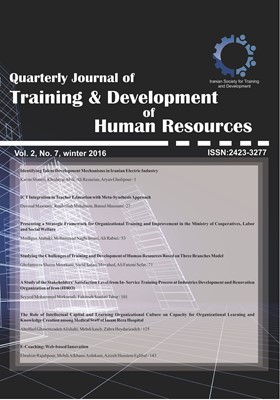-
-
List of Articles
-
Open Access Article
1 - Identifying Talent Development Mechanisms in Iranian Electric Industry
-
Open Access Article
2 - Identifying Talent Development Mechanisms in Iranian Electric Industry
Khodayar Abili -
Open Access Article
3 - Identifying Talent Development Mechanisms in Iranian Electric Industry
Khodayar Abili Aryan gholipour -
Open Access Article
4 - ICT Integration in Teacher Education with Meta-Synthesis Approach
داود معصومی روح اله مهدیون بتول معصومی -
Open Access Article
5 - Presenting a Strategic Framework for Organizational Training and Improvement in the Ministry of Cooperatives, Labor and Social Welfare
مژگان اتابکی محمدنقی ايماني گله پردسری علی ربیعی -
Open Access Article
6 - Studying the Challenges of Training and Development of Human Resources Based on Three Branches Model
gholamreza shams mourkani علی فاطمی صفت -
Open Access Article
7 - Studying the Challenges of Training and Development of Human Resources Based on Three Branches Model
gholamreza shams mourkani -
Open Access Article
8 - Studying the Challenges of Training and Development of Human Resources Based on Three Branches Model
gholamreza shams mourkani علی فاطمی صفت -
Open Access Article
9 - A Study of the Stakeholders’ Satisfaction Level from In- Service Training Process at Industries Development and Renovation Organization of Iran (IDRO)
سیدمحمد میرکمالی فهیمه سعادتی تبار -
Open Access Article
10 - The Role of Intellectual Capital and Learning Organizational Culture on Capacity for Organizational Learning and Knowledge Creation among Medical Staff of Imam Reza Hospital
abolfazl ghasemzadeh alishahi مهدی کاتب زهرا حیدری زاده -
Open Access Article
11 - E-Coaching: Web-based Innovation
Ebrahim Rajabpour مهدی افخمی اردکانی عزیزه حسینی اقبال
-
The rights to this website are owned by the Raimag Press Management System.
Copyright © 2017-2025







